#Sierra Morena
Text
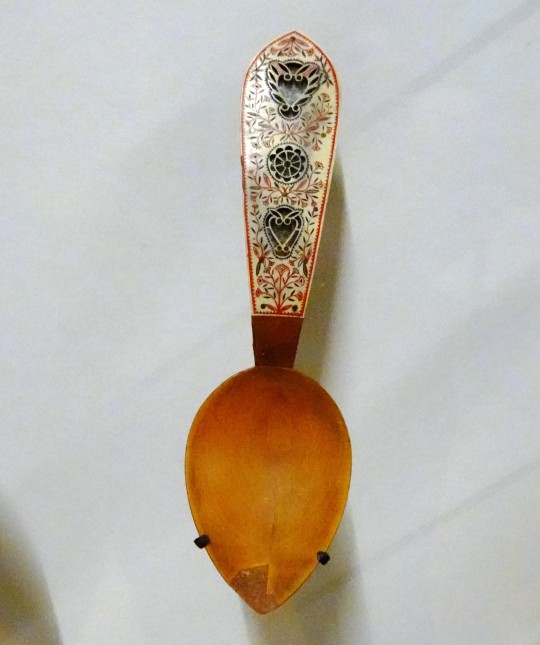
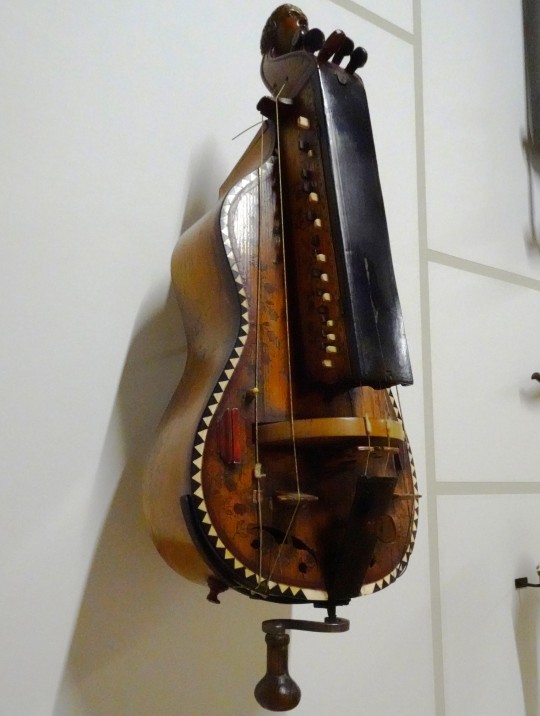



Marseille, le MuCEM et sa nouvelle collection permanente (à mes yeux, bien plus intéressante et mieux présentée que la précédente...)
Il y aura un nombre important de billets !!!
cuillère en bois, corne et métal, "J.B.P." - Bretagne, 1853
Vielle à roue, "Claude Pimpard" - Allier, 1899
corne à huile, "L.M." - Camargue, XIXe s.
crémaillère à dents - France, 1848
cuillères : Ariège fin XIXe s. ; Bretagne 1853; Fuencaliente, Sierra Morena, Espagne début XXe s. ; "L.G.", Lassales, Hautes-Pyrénées, 1930
#marseille#MuCEM#cuillère#bretagne#auvergne#vielle#vielle à roue#corne#camargue#taureau#crémaillère#sierra morena#hautes-pyrénées
5 notes
·
View notes
Photo


SIERRA MORENA
Silverio Lanza fue pseudónimo, bien conocido, de Juan Bautista Amorós (1858-1912) , cuya familia tenía propiedades en Bujalance (Córdoba). Fue escritor admiradísimo por la Generación del 98, al que Pío Baroja consideró “pensador de una originalidad violenta, de una independencia huraña y salvaje” e “ingenio peregrino”; al que Rubén Darío tuvo por “cuentista original”; y cuyas obras editó post mortem Ramón Gómez de la Serna en 1919, seguramente encandilado por su raro humorismo.
En uno de sus Cuentecitos sin importancia (1892, 3ª ed.), Silverio Lanza describió esta sierra que separa la Mancha de Las Andalucías; a Castilla, de la Novísima Castilla... (Modernizo grafía):
“La sierra que separa la Mancha de Andalucía debe llamarse morena, y así se llama. Allí hay lugares a propósito para los más románticos sueños de amor, los más crueles asesinatos y los duelos sin piedad. Aquello es un monumento gigante levantado a la superioridad de lo malo y a la superioridad de lo bello. Por todas partes lleno de cruces, cifras y fechas, como libro que anota un crítico algo ilustrado. Un montón de piedras que recuerda una promesa, un árbol cortado que es señal de un juramento, cuevas que han oído gritos de dolor y besos de enamorados, una tierra que ha absorbido vino y sangre y un firmamento que ha contemplado impávido todas estas cosas dando quizás día tormentoso al alegre galán y serena noche de luna al temeroso bandido”.
3 notes
·
View notes
Text
¿El ERC visitará Andalucía? El 41º Rallye Sierra Morena será pre inspección en 2024.
¡Tenemos emocionantes noticias para todos los amantes de los rallyes en Andalucía y especialmente para nuestro querido Rallye Sierra Morena! En su 41ª edición, el Rallye Internacional Sierra Morena ha sido seleccionado como preinspección para el prestigioso Campeonato Europeo de Rallyes FIA ERC – European Rally Championship.
Click para ampliar
El acuerdo para esta importante preinspección se…

View On WordPress
#Andalucia#Andalucia europeo#Andalucia Rally#Andalucia Rally Team#Andalucia Rallyes#Calendario Andalucia#cordoba#ERC#Rally#RallyCar#SCER#Sierra Morena#Sierra Morena ERC#SuperCER#WRC
0 notes
Text
Sierra de los Puntales en Gravel
Descubriendo Sierra Morena desde la Sierra de Los Puntales (Córdoba), (Andalucia)
A tan solo pocos kilómetros de casa emerge un lugar increíble, donde la naturaleza sigue su curso natural y la mano del hombre interviene tan solo en labores agrícolas y ganaderas.
Sierra Morena
Sierra Morena, un entorno plagado de sucesivas elevaciones donde el bosque mediterráneo plagado de encinas, alcornoques, pinos y algún que otro olivar dan color a nuestra ruta ciclista.
En este momento…

View On WordPress
1 note
·
View note
Text









⠀⠀⠀⠀⠀⠀que nos volvamos a ver . .
#cris morena day#cris morena#casi angeles#rebelde way#lali esposito#china suarez#Jazmin romero#nico Vazquez#victorio d'alessandro#peter lanzani#Benjamin rojas#Agustín sierra#cachete sierra#nico riera#rochi igarzabal
12 notes
·
View notes
Text

José Alonso del Rivero (Spanish, 1781-1818)
Carlos III entregando las tierras a los colonos de Sierra Morena, 1805
Real Academia de Bellas Artes de San Fernando, Madrid
#José Alonso del Rivero#spanish art#spanish#1800s#art#fine art#european art#classical art#europe#european#fine arts#oil painting#europa#mediterranean#Carlos III entregando las tierras a los colonos de Sierra Morena#iberian#iberia#neoclassical#spanish neoclassical#neoclassical art
18 notes
·
View notes
Text
john cale was so real… andalucia when can i see ya… literally
#i miss cordobaaaa it’s so pretty#all of the sierra morena really floored me it’s stunning#the food/wine was rlly good too ugh i miss it so bad :(
5 notes
·
View notes
Text
PARQUE NATURAL SIERRA DE HORNACHUELOS, ABUNDANTE Y VARIADA NATURALEZA; Por Rosana Saburo
Córdoba puede presumir además de cuatro inscripciones en la Lista de Patrimonio Mundial, La Mezquita-Catedral, el centro histórico, la Fiesta de Los Patios y Medina Azahara de mucha naturaleza reconocida y protegida como parque natural, uno de estos enclaves es el Parque Natural Sierra de Hornachuelos.
Era un día de primavera, la floración estaba en su apogeo, muchos insectos, especialmente…

View On WordPress
#almodovar del rio#cordoba#dehesas de sierra morena#embalse bembezar#posadas#reserva de la biosfera#rio bembezar#sierra de hornachuelos
0 notes
Text


Sierra Morena Fire Salamander (Salamandra s. morenica), family Salamandridae, Andalucía, Spain
Poisonous.
photograph by Peđro V. Đíaz
275 notes
·
View notes
Text
Reading the World

In 2023, I challenged myself to watch a movie from every country in the world during the year, which I more or less succeeded. At the start of this year I decided to read a book from every country in the world (without the time restraint) and got a map to track my progress along with a challenge on Story Graph.
List of countries and books below the cut
Current count: 37
Afghanistan:
Albania:
Algeria:
American Samoa:
Andorra: Andorra: a play in twelve scenes by Max Frisch
Angola: The Whistler by Ondjaki
Anguilla:
Antigua and Barbuda:
Argentina: Our Share of the Night by Mariana Enríquez
Armenia:
Aruba:
Australia:
Austria:
Azerbaijan:
Bahamas:
Bahrain:
Bangladesh:
Barbados:
Belarus:
Belgium:
Belize:
Benin:
Bermuda:
Bhutan: Folktales of Bhutan by Kunzang Choden
Bolivia:
Bosnia and Herzegovina:
Botswana:
Brazil:
British Virgin Islands:
Brunei:
Bulgaria:
Burkina Faso:
Burundi:
Cambodia:
Cameroon: The Impatient by Djaïli Amadou Amal
Canada: The Gift is in the making: Anishinaabeg Stories retold by Amanda Strong and Leanne Betasamosake Simpson
Canary Islands: Dogs of Summer by Andrea Abreu
Cape Verde:
Cayman Islands:
Central African Republic: Co-wives, Co-widows by Adrienne Yabouza
Chad:
Chile: The Twilight Zone by Nona Fernández
China: The Secret Talker by Geling Yan
Christmas Islands:
Cocos Islands:
Colombia:
Comoros:
Cook Islands:
Costa Rica:
Croatia:
Cuba:
Curacao:
Cyprus:
Czech Republic:
Dem. Rep. of Congo:
Denmark:
Djibouti:
Dominica:
Dominican Republic:
Ecuador:
Egypt:
El Salvador:
Equatorial Guinea:
Eritrea:
Estonia:
Eswatini:
Ethiopia:
Falkland Islands:
Faroe Islands:
Fiji:
Finland:
France: The Count of Monte Cristo by Alexandre Dumas
French Guiana:
French Polynesia:
Gabon:
Gambia:
Georgia:
Germany: At the Edge of the Night by Friedo Lampe
Ghana: Wife of the Gods by Kwei Quartey
Gibraltar:
Greece:
Greenland:
Grenada:
Guam:
Guatemala:
Guernsey:
Guinea:
Guinea-Bissau:
Guyana:
Haiti:
Honduras:
Hong Kong:
Hungary:
Iceland:
India: Coming Out as Dalit: A Memoir Of Surviving India's Caste System by Yashica Dutt
Indonesia:
Iran: Darius the Great is Not Okay by Abid Khorram
Iraq: Frankenstein in Baghdad by Ahmed Saadawi
Ireland:
Isle of Man:
Israel:
Italy:
Ivory Coast:
Jamaica: When Life Gives You Mangos by Kereen Getten
Japan:
Jordan:
Kazakhstan:
Kenya:
Kiribati:
Kosovo:
Kuwait:
Kyrgyzstan:
Laos:
Latvia:
Lebanon: Beirut Hellfire Society by Rawi Hage
Lesotho:
Liberia:
Libya: Zodiac of Echoes by Khaled Mattawa
Liechtenstein:
Lithuania:
Luxembourg:
Macedonia:
Madagascar:
Malawi:
Malaysia:
Maldives:
Mali:
Malta:
Marshall Islands:
Mauritania:
Mauritius:
Mexico: Silver Nitrate by Silvia Morena-Garcia
Micronesia:
Moldova:
Monaco:
Mongolia:
Montenegro:
Montserrat:
Morocco:
Mozambique:
Myanmar: Smile as They Bow by Nu Nu Yi
Namibia:
Nauru:
Nepal:
Netherlands: We Had to Remove this Post by Hanna Bervoets
New Caledonia:
New Zealand:
Nicaragua:
Niger:
Nigeria: Buried Beneath the Baobab Tree by Adaobi Tricia Nwaubani
Niue:
Norfolk Island:
North Korea: A Thousand Miles to Freedom: My Escape from North Korea by Eunsun Kim
Northern Mariana Islands:
Norway: Blind Goddess by Anne Holt
Oman:
Pakistan: Hijab Butch Blues by Lamya H
Palau:
Palestine: The Skin and Its Girl by Sarah Cypher
Panama:
Papua New Guinea:
Paraguay:
Peru:
Philippines:
Pitcairn Islands:
Poland: Return from the Stars by Stanisław Lem
Portugal:
Puerto Rico:
Qatar:
Rep. of the Congo:
Romania:
Russia:
Rwanda: Baking Cakes in Kigali by Gaile Parkin
Saint Barthelemy:
Saint Helena, Ascension and Tristan da Cunha:
Saint Kitts and Nevis:
Saint Lucia:
Saint Martin:
Saint Pierre and Miquelon:
Saint Vincent and the Grenadines:
Samoa:
San Marino:
Sao Tome and Principe:
Saudi Arabia:
Senegal:
Serbia:
Seychelles:
Sierra Leone:
Singapore:
Sint Maarten:
Slovakia:
Slovenia:
Solomon Islands:
Somalia:
South Africa:
South Korea:
South Sudan:
Spain:
Sri Lanka: The Seven Moons of Maali Almeida by Shehan Karunatilaka
Sudan: The Translator: A Memoir by Daoud Hari
Suriname:
Sweden: Fire from the Sky by Moa Backe Åstot
Switzerland:
Syria: The Book Collectors: A Band of Syrian Rebels and the Stories That Carried Them Through a War by Delphine Minoui
Taiwan:
Tajikistan: The Sandalwood Box: Folk Tales from Tadzhikistan by Hans Baltzer
Tanzania:
Thailand:
Togo:
Tokelau:
Tonga:
Trinidad and Tobago:
Tunisia:
Turkey:
Turkmenistan:
Turks and Caicos Islands:
Tuvalu:
Uganda:
Ukraine:
United Arab Emirates:
United Kingdom: Poyums by Len Pennie
United States of America: Reclaiming Two-Spirits: Sexuality, Spiritual Renewal & Sovereignty in Native America by Gregory D. Smithers
United States Virgin Islands:
Uruguay:
Uzbekistan:
Venezuela:
Vietnam:
Wallis and Futuna:
Western Sahara:
Yemen:
Zambia:
Zimbabwe: We Need New Names by NoViolet Bulawayo
13 notes
·
View notes
Text
7th part of the bookscans of Al Andalus. Historical Figures, here's the previous part
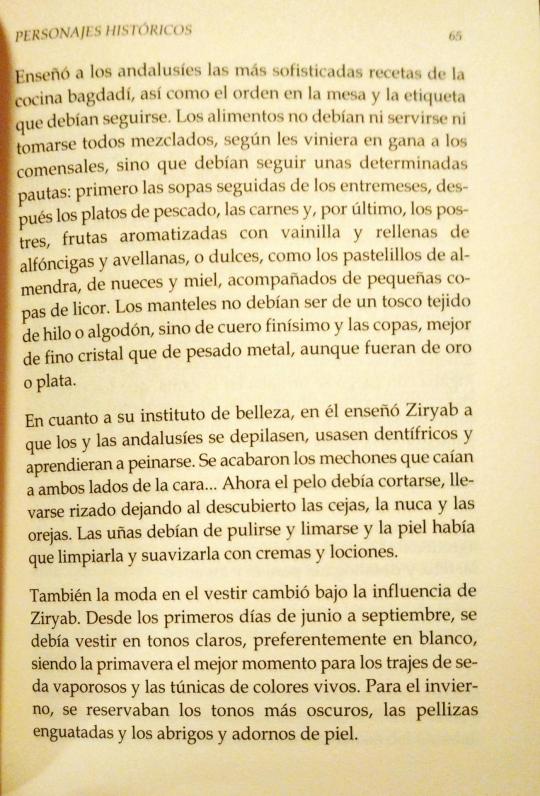
He taught the Andalusians the most sophisticated recipes of Baghdad cuisine, as well as the order at the table and the etiquette that had to be followed. The food should not even served or taken all mixed, as the diners wanted, but they had to follow certain guidelines: first the soups followed by the hors d'oeuvres, then the fish dishes, the meats and, finally, the desserts, fruits flavored with vanilla and stuffed with alphoncigas and hazelnuts, or sweets, such as almond, walnut and honey pastries, accompanied by small glasses of liquor. The tablecloths should not be of a coarse woven linen or cotton,nbut of very fine leather and the cups, better of fine crystal than of heavy metal, even if they were gold or silver.
As for his beauty institute, Ziryab taught the Andalusian to shave their hair, use toothpaste and to comb their hair. The strands that fell on both sides of the face ended... Now the hair had to be cut, worn curly, revealing the eyebrows, the nape of the neck and the ears. Nails should be polished and filed and the skin had to be cleaned and softened with creams and lotions.
Fashion in clothing also changed under the influence of Ziryab. Since the first days from June to September, they had to dress in light colors, preferably in white, spring being the best time for suits of gauzy silk and brightly colored tunics. For winter, they reserved the darker tones, the quilted pelisses and the fur coats and decorations.
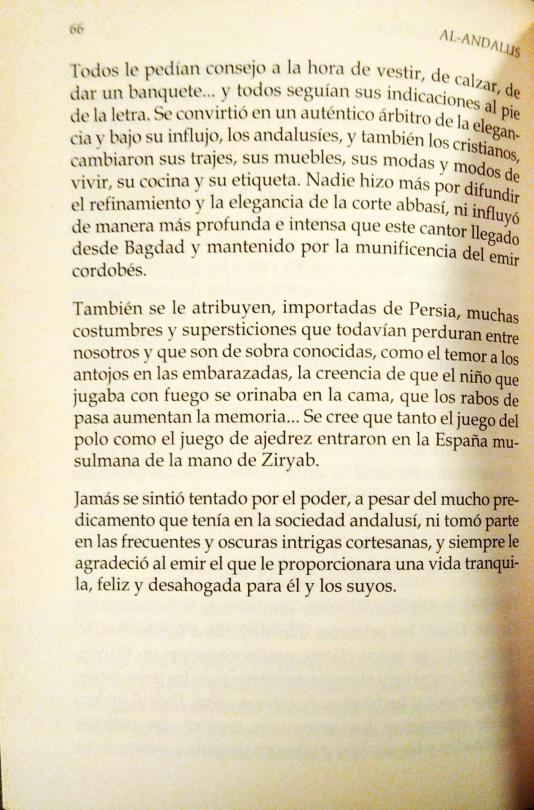
Everyone asked him for advice when it came to dressing, fitting shoes, giving a banquet... and everyone followed his instructions fully. It became a real
arbiter of elegance and under his influence, the Andalusians, and also the
Christians, changed their clothes, their furniture, their fashions and ways of living, their kitchen and their etiquette. No one did more to spread refinement and elegance of the Abbasid court, nor did he influence in a more profound and intense way than this singer arrived from Baghdad and maintained by the munificence of the Emir of Córdoba.
Also attributed to him, imported from Persia, are many customs and
superstitions that still exist among us and that are too known, such as the fear of cravings in pregnant women, the belief thatbthe boy who played with fire wet the bed, the tails of raisin increase memory... It is believed that both the game of polo and the game of chess entered Muslim Spain at the hands of Ziryab.
He never felt tempted by power, despite the much premedication that he had in Andalusian society, nor did he take part in the frequent and dark courtesans intrigues, and he always thanked the emir for providing him with a better, calm, happy and comfortable life for him and his people.

Tarub: the favorite of Abd al-Rahman II
All historians recognize that this emir was a complete womanizer. The young virgins, arriving from all corners, populated the harem of this man, so different from his father, the strict al-Hakam, who had bequeathed him a kingdom almost pacified, with the Treasury coffers filled to overflowing, which allowed him dedicate to all the pleasures that life can offer. Of his many concubines, wives and favorites, there was one whom it seems he loved more than all the others, Tarub, whose success with the caliph was perhaps due to her being surly, selfish and desired.
She must have been very beautiful, at least in the eyes of the enamored emir who, a man of great education and good poet, said of her: "Whenever I see the sun rise that illuminates reminds me of Tarub, a girl adorned with the trappings of beauty:
"The eye that contemplates it believes it sees a beautiful gazelle in it".
When he was not on an expedition, Abd al-Rahman II, like all sovereigns and
nobles of the era, went hunting, to the mountains of Sierra Morena or to the marshes of the Guadal-
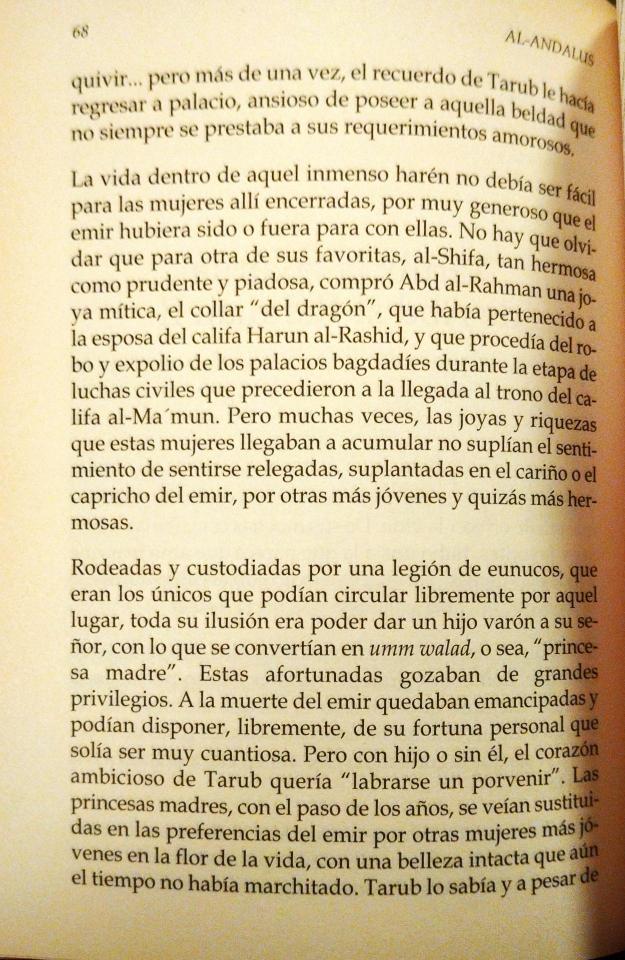
quivir... but more than once, the memory of Tarub made him return to the palace,
eager to possess that beauty who did not always respond to his amorous requirements.
Life inside that immense harem it couldn't have been easy for the women locked up there no matter how generous the emir had been or was towards them. There is no need to forget that for another of his favorites, al-Shifa, as beautiful as prudent and pious, Abd al-Rahman bought a mythical jewel, the dragon necklace, which had belonged to the wife of the caliph Harun al-Rashid, and that it came from the robbery and looting of the badgadi palaces during the period of the civil struggles that preceded the accession to the throne of the caliph al-Ma'mun. But many times, the jewels and riches that these women
accumulated did not make up for the feeling of feeling relegated, supplanted in the affection or whim of the emir, by others younger and perhaps more beautiful.
Surrounded and guarded by a legion of eunuchs, who were the only ones who could move freely through that place, their whole dream was to be able to give
a male child to their lord, with which they became umm walad, that is, "princess mother." These lucky ones enjoyed great privileges. To the death of the emir were emancipated and could freely dispose of
her personal fortune that used to be very large. But with or without a child, the
ambitious heart of Tarub wanted to “make a future for herself.” The princesses
mothers, as the years went by, saw themselves replaced in the prime of life,
with an intact beauty that time had not yet withered. Tarub knew it and despite
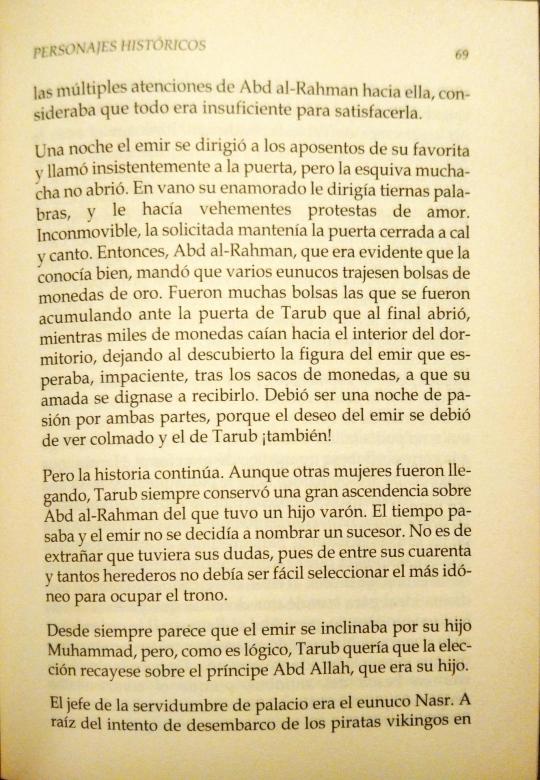
Abd al-Rahman's multiple attentions towards her, she considered that everything was insufficient to satisfy it.
One night the emir went to his favorite's chambers and called insistently at the door, but the elusive girl did not open it. In vain her lover spoke tender words to her, and made vehement protests of love. Unmovable, the requested one kept the door firmly closed. Then Abd al-Rahman, who clearly knew her well, ordered that several eunuchs carried bags of gold coins. There were many bags that were accumulating before the gate of Tarub that he finally opened, while thousands of coins fell into the bedroom, exposing the figure of the emir who waited, impatiently, behind the bags of coins, for his beloved would deign to receive him. It must have been a night of passion for both of us.
parts, because the emir's wish must have been fulfilled and Tarub's too!
But the story continues. Although other women arrived, Tarub always retained a great ancestry over Abd al-Rahman from whom he had a son. Time passed and the emir could not decide to name a successor. It is not surprising that he had his doubts, since among his forty heirs it couldn't be easy to select the most suitable one to occupy the throne.
It always seems that the emir was inclined towards his son Muhammad, but, of course, Tarub wanted the choice to fall to Prince Abd Allah, who was her son.
The head of the palace servants was the eunuch Nasr. Following the attempt to
landing of the viking pirates in

al-Andalus, Nasr had distinguished himself by his heroic behavior and by having defeated them in the battle that took place near Tablada. All this did that the emir appreciated him in a special way and that his influence at court was increasingly greater. Nasr and Tarub got along very well, they were both ambitious, and the princess mother, desperate to see her son named
successor decided, with the support of the eunuch, to plot a plot, quite sinister indeed, to ensure the much-desired succession to his son Abd Allah. The plot involved poisoning the prince who was presumed to be possible heir, Muhammad,... and by the way, and just in case the fact aroused suspicion, also ending the father, that is, the emir.
It was a very risky plan for Tarub but she was sure that with the complicity of Nasr, one of the strongest men at court and,
possibly the closest to the emir, she could not fail. And it happened that, in
those days, a very famous doctor, Harrán, arrived at the Cordoban court, who
came from Mesopotamia. Nasr asked him to prepare a drink poisoned and the doctor did not dare to deny him. Afterwards, he felt remorse and confessed the plot to another of the princess mothers, Farj, who
informed the emir of the conspiracy that was being hatched against him. The eunuch presented the deadly concoction to the emir, offering it to him as the ideal medicine to cure an ailment that he had been suffering from for some time, but Abd al-Rahman II ordered him to take it himself. Nasr was trapped and had no more remedy than drinking the poisoned drink. It was of little use to him to run in searchbof the antidote, because the counterpoison prepared by the doctor al-Harraní, wasn't effective and the eunuch died.
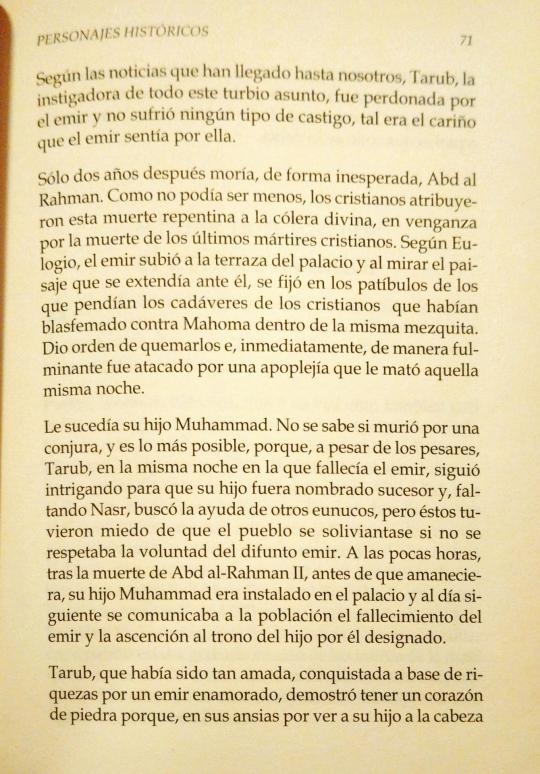
According to the news that has reached us, Tarub, the instigator of all this murky affair, was forgiven by the emir and did not suffer any type of punishment, such was
the affection that the emir felt for her.
Only two years later, Abd al Rahman died, unexpectedly. The Christians attributed this sudden death to divine anger, in
revenge for the death of the last Christian martyrs. According to Eulogio, the emir went up to the terrace of the palace and, looking at the landscape that stretched before him, noticed the scaffolds from which hung the corpses of the Christians who had blasphemed against Muhammad within the same mosque. He gave the order to burn them and, immediately, in a sudden manner, he was attacked by an apoplexy that killed that same night.
He was succeeded by his son Muhammad. It is not known if he died as a result of a conspiracy, and it is the most
possible, because, despite the regrets, Tarub, on the same night in which the
emir, continued to intrigue so that his son would be named successor and, with Nasr missing, she sought the help of other eunuchs, but they were afraid that the people would became angry if the will of the late emir was not respected. A few hours after the death of Abd al-Rahman II, before dawn, his son Muhammad wasinstalled in the palace and the next day the population was informed of the
death of the emir and the ascension to the throne of the son designated by him.
Tarub, who had been so loved, conquered with wealth by an emir in love, proved to have a heart of stone because, in her eagerness to see his son in the lead
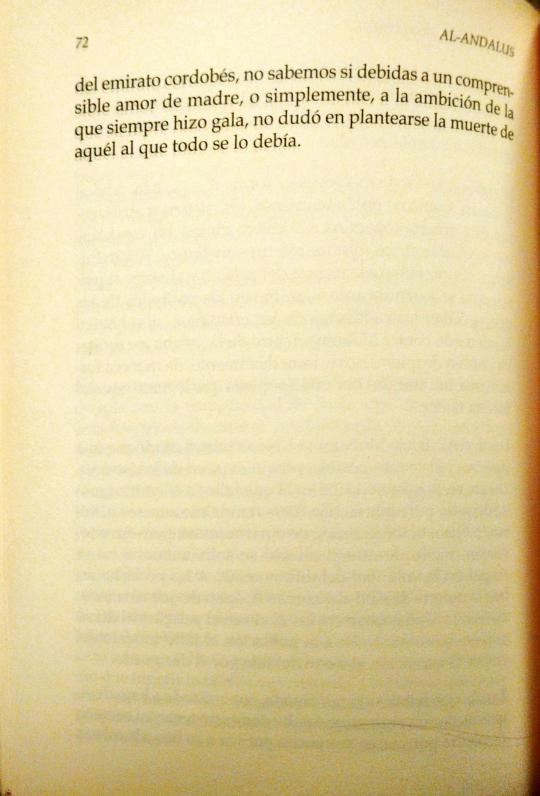
of the emirate of Cordoba, we do not know if due to an understandable love as a mother, or simply, to the ambition that she always displayed, she did not hesitate to consider the death of the one to whom she owed everything.

Abbas ben Firnas: the first aviator
Abd al-Rahman II was, without a doubt, the most cultured of all the emirs and
Hispano-Umayyad caliphs. Only one of his descendants, al-Hakam II, could compare him in terms of intellectual curiosity.
Poets, writers, philosophers, who in turn were also almost all astrologers, to whom
which the Muslims attached so much importance, were part of the court
by Abd al-Rahman. We will mention some of them, of great talent, who excelled in different areas of knowledge, such as Abd Allah ben al-Shamir, magnificent versifier; Ibrahim ben Sulayman al-Shamí, whose religious and mystical poems achieved great relevance throughout the Muslim world; Uthman ben al-Muthanna, grammarian, who became a preceptor to the royal princes; Said ben Farach al-Rashshash, who knew more than 4,000 mnemonics poems by heart and his brother Muhammad, who established the measurement of the Andalusian cubit, whose pattern was engraved on one of the walls of the main mosque from Córdoba... The list of wise men would be very long. But among all of them the figure of Abbas ben Firnas is especially important.
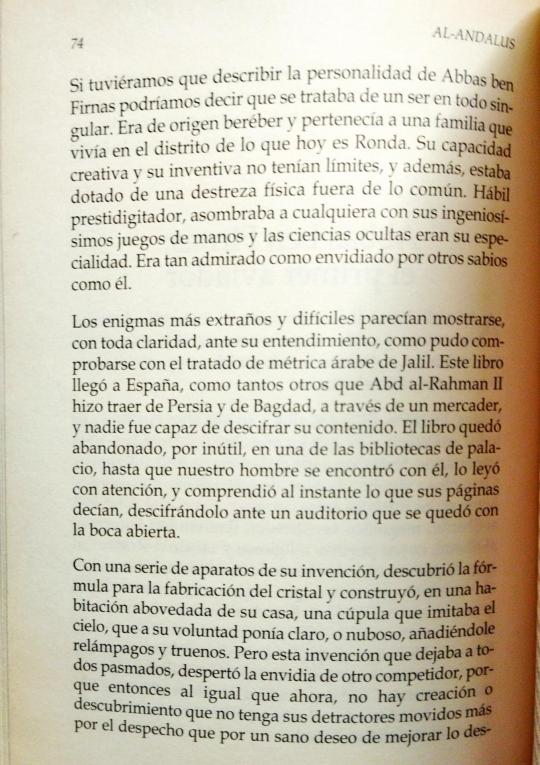
If we had to describe the personality of Abbas ben Firnas we could say that it was a being in every way singular. He was of Berber origin and belonged to a family that lived in the district of what is now Ronda. His creative ability and his inventiveness had no limits, and in addition, he was endowed with physical dexterity out of the ordinary. Skilled conjurer, he amazed anyone with his ingenious sleight of hand and occult sciences were his specialty. Was
as admired as envied by other wise men like him.
The strangest and most difficult enigmas seemed to show themselves, with complete clarity, before their understanding, as could be verified with the treatise on Arabic metrics of Jalil. This book arrived in Spain, like so many others that Abd al-Rahman II had brought
from Persia and Baghdad, through a merchant, and no one was able to decipher his content. The book was abandoned, as useless, in one of the libraries of palace, until our man came across it, read it carefully, and instantly understood what its pages said, deciphering it before a
audience that was left with their mouths open.
With a series of devices of his invention, he discovered the formula for the manufacturing glass and built, in a vaulted room in his house, a dome that imitated the sky, which at will made it clear or cloudy, adding lightning and thunder. But this invention that left everyone stunned, aroused the envy of another competitor, because then just as that now, there is no creation or discovery that does not have its detractors, motivated more by spite than by a healthy desire to improve what was
#al andalus historical figures#al andalus personajes históricos#book scans#bookblr#historyblr#al andalus#al andalus history#ziryab#zyriab the singer of baghdad#abu l-hasan ali ibn nafi`#abd al rahman ii#abd al rahman ii of córdoba#tarub#abbás ibn firnás#emirate of cordoba#spanish history#tw death#tw mysoginy#(for tarub's chapter)
13 notes
·
View notes
Text
Measuring some 45 centimeters long and weighing between 24 and 32 kilos, they are triangular in shape, resembling a Toblerone bar. There are only three of them, and one is broken in half, but the study of these three lead ingots, never studied before and from the Los Escoriales de Doña Rama (Belmez, Córdoba) deposit, yield enough information to state that ancient Cordoba, the capital of the Roman Empire's region of Baetica, and whose territory occupied what is today the north of the province, encompassing the Guadiato Valley, Los Pedroches, and some districts of Jaen, Ciudad Real and Badajoz, was the western ancient world's main center for the smelting of lead, a metal used to produce a multitude of everyday tools, such as spoons, tiles, pipes, etc. ....
The ingots, dating from the first century A.D., were unearthed in the twentieth century during work on the Maghreb-Europe gas pipeline, and were kept in the Belmez Museum and in private homes. Two of them bear an identifying mark, making it possible to reveal part of their history and to confirm the great importance of mining importance in the central Sierra Morena area during the Roman period. This mark is actually two letters, "S S," referring to the Societas Sisaponensis, a mining company originally from La Bienvenida (Almodóvar del Campo, Ciudad Real), a land famous for the production of cinnabar, but that must have been headquartered in Cordoba.
Read more.
7 notes
·
View notes
Text
Pepe López deja el SCER.
El vigente ganador del SCER en la pasada temporada 2022 Pepe López obligado a dejar el campeonato tras la polémica surgida en la cita inaugural, el Rallye Sierra Morena.
En dicho rallye, un equipo tuvo intención de presentar una reclamación contra Pepe López por disputar la carrera sin tener en posesión el carnet de conducir y el desenlace de aquel lío se ha resuelto hace unos minutos, con una…

View On WordPress
#ERC#MSI#Pepe López carnet de conducir#Pepe lópez deja el SCER#pepe lopez#Pepe Lopez Sierra Morena#Rally#Rally2#RallyCar#RFEdA#SCER#Sierra Morena SCER#Skoda#Teo Martin#Teo Martin Motorsport#Teo Martin Pepe López#WRC
1 note
·
View note
Photo









Marbled Monday
Today we bring you two official documents from King Charles III of Spain from 1767—the first was published April 4 and the second on July 5. These documents pertain to the settlement of six thousand Catholic Flemish and German settlers in Sierra Morena. Both are certified by Don Ignacio Esteban de Higareda, advisor to the king. Both documents were printed in the Office of Don Antonio Sanz, official printer of the king and his counsel.
The marbling is one of my favorites that I’ve seen—a fantasy pattern in purple, red, and cream. Something particularly interesting (to me, anyway!) is the evidence of light damage on the marbling, especially on the back of the first book shown here (the third image). You can see that the top of the book has been bleached quite light, while the left side has been bleached slightly less and the right side is still its original color. From this we can tell something about how the book has been stored—there was most likely a smaller book or bookend in front of it near a window or other light source for quite some time, causing the top to bleach while the bottom stayed bright! At some point, an even smaller book blocked just the bottom right side, causing the left side to bleach a bit as well. These are not the original bindings for these documents (our best guess is that these are 20th century bindings) and evidence of light damage can be seen on all sides of the covers shown here.
All of our books here in Special Collections are kept in darkened spaces for the most part—we only turn the lights on when a person is in the stacks and needs to see! This helps prevent light damage like you see here. If you have special books you want to keep looking nice, we recommend keeping them in the dark!
View more Marbled Monday posts.
-- Alice, Special Collections Department Manager
#Marbled Monday#King Charles III#King Charles III of Spain#Spain#1767#18th century#Don Ignacio Esteban de Higareda#Don Antonio Sanz#fantasy pattern#marbled paper#marbling#light damage#preservation
71 notes
·
View notes
Text









⠀⠀⠀⠀⠀⠀que nos volvamos a ver . .
#cris morena#cris morena event#casi angeles#rebelde way#teen angels#china Suarez#lali esposito#peter Lanzani#Agustín sierra#Maria del cerro#Emilia attias#gime accardi#nico Vazquez#nico riera#Rochi Igarzabal#victorio d'alessandro#cris morena day
11 notes
·
View notes
Text

Francisco de Goya y Lucientes (Spanish, 1746-1828)
Las Santas Justa y Rufina, 1817
Sacristía de los Cálices, Seville Cathedral
Santa Cruz, Sevilla, Andalucía
Justa and Rufina are the patron saints of Seville, whose cathedral is seen in the background.
Their legend states that they were sisters and natives of Seville who made fine earthenware pottery for a living, with which they supported themselves and many of the city's poor. Traditionally, they are said to have lived in the neighborhood of Triana. Justa was born in 268 AD, Rufina in 270 AD, of a poor but pious Christian family. During a pagan festival, they refused to sell their wares for use in these celebrations. In anger, locals broke all of their dishes and pots. Justa and Rufina retaliated by smashing an image of Venus.
The city's prefect, Diogenianus, ordered them to be imprisoned. Failing to convince them to renounce their faith, he had them tortured on the rack and with iron hooks. This method also having failed, they were imprisoned, where they suffered from hunger and thirst.
They were then asked to walk barefoot to the Sierra Morena; when this did not break their resolve, they were imprisoned without water or food. Justa died first. Her body, thrown into a well, was later recovered by the bishop Sabinus. Diogenianus believed that the death of Justa would break the resolve of Rufina. However, Rufina refused to renounce her faith and was thus thrown to the lions. The lion in the amphitheatre, however, refused to attack Rufina, remaining as docile as a house cat. Infuriated, Diogenianus had Rufina strangled or beheaded and her body burned. Her body was also recovered by Sabinus and buried alongside her sister in 287 AD.
#Goya#spanish art#spanish#spain#christian#catholic#Francisco de Goya y Lucientes#art#fine art#european art#classical art#europe#european#fine arts#oil painting#europa#mediterranean#christian art#christianity#christentum#catholic art#catholicism#roman catholic#Justa y Rufina#martyr#martyrs#1800s#roman empire
40 notes
·
View notes